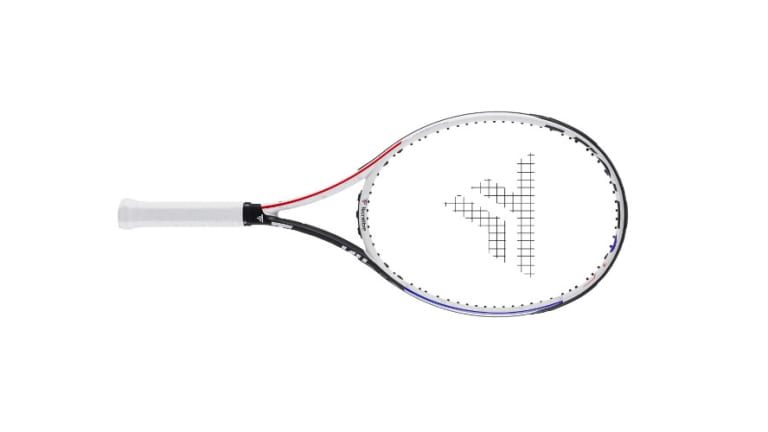SPECS
Price: $230
Head Size: 98 sq. in.
Length: 27 in.
Weight: 11.7 oz.
Balance: 7 pts. HL
Swingweight: 321
RA: 69
Beam Width: 22.5 mm
The heaviest T-Fight offers an impressive blend of power, spin and dependability
Published Sep 14, 2021

SPECS
Price: $230
Head Size: 98 sq. in.
Length: 27 in.
Weight: 11.7 oz.
Balance: 7 pts. HL
Swingweight: 321
RA: 69
Beam Width: 22.5 mm
Tecnifibre racquets have a problem.
It has nothing to do with the construction of their frames, which always pays attention to the finest details. Nor is it a matter of appearance—with design input from Lacoste, the racquets receive high marks in the looks department. No, the issue for Tecnifibre is more of an identity crisis.
Not enough players seem to know how good their racquets are.
But if recent performance is any indication, that’s bound to change. Over the past handful of years the company has been putting out consistently worthy frames that are often referred to as under-the-radar or hidden gems. And the Grand Slam accomplishments of endorsers Daniil Medvedev and Iga Swiatek will undoubtedly shine a brighter light on the brand. There’s an international business advisory firm with a recurring advertising theme that even though it may not be a household name, those in the know are quite familiar with its accomplishments. Well, savvy tennis techs, retailers and players know about Tecnifibre racquets.
The T-Fight RS 315 should only help bolster its reputation. Living up to its moniker, it’s something of a brawler that can mix it up from all areas of the court. At its weight, it probably will appeal to a smaller set of advanced players, but would do well in the hands of any competitor that appreciates the benefits of a little extra mass.
From the ground, the T-Fight embodied many of the characteristics of the modern control-oriented frame. The feel from the pentagonal R-shaped beam was noticeably firm, yet not uncomfortable. I typically prefer frames in this weight class to have a lower flex for a plusher response, but negative feedback was minimal—the definition of crisp and clean contact.
It packed enough punch for a put-away or get out of a pinch, but I found the racquet’s quickness through the strike zone to be its biggest power source. It also helped take advantage of the 16x19 string pattern and a full bed of poly (Tecnifibre Ice Code 18g) to apply plenty of spin to the ball. It was effective at creating angles and deep high-rollers to mix in with bread-and-butter drives.
As with the lower flex, I wouldn’t mind a higher swing weight for increased plow through. I felt that the lighter T-Fight RS 305—Medvedev’s racquet of choice— with more of its mass in the head was actually superior in this department. But that can be remedied with some lead tape, and from an overall stroke production standpoint I had few qualms with the 315. Players who like to take healthy cuts should have no trouble producing a heavy ball.
Serves were also quite effective and some of my favorite shots to hit with the racquet. It wasn’t a natural rocket launcher that gave an immediate bump in mph. However, I found the combination of the firm beam and quickness through the air made up for the tempered power. And whether aiming a flat delivery down the T or a kicker out wide, the fine directional control was an invitation for more aggression and braver targets.
At net the T-Fight proved its all-court bona fides. A smooth handler, it capably and predictably punched volleys deep into the opposing court. Nimble as it was, the racquet still held its own against heavy-hitting with little wobble or brassiness off-center. The ball did jump in and out of the string bed quickly, so controlling depth on touch shots and half volleys took some time. This was another area where I wouldn’t mind more flex and better ball connection.
Living up to its moniker, it’s something of a brawler that can mix it up from all areas of the court.
I had two other minor complaints about the racquet that hardly rose to the level of serious grievances. First, the shape of the grip was a bit too oval. It reminded me of older Head Prestiges. It struck me as an acquired taste that might bother players accustomed to rounder grips, myself among them. Or they might not care at all.
The second was something another of our testers (Mitch Case) brought up in his review of the T-Fight RS 305. The etching of red and blue decals on one side of the throat and head is unusually pronounced. So much so, that I could feel the “sharpness” when setting my racquet for a forehand or waiting to return serve. Perhaps there’s a practical use for this—knowing exactly which side of the racquet you’re hitting with, or opening a beer bottle?—but I’d opt for a smoother, uniform surface.
All in all, though, the T-Fight RS 315 is another solid offering from Tecnifibre. It’s quick and responsive with a nice combination of power, spin and dependability. It registers as the type of frame counterpunchers can rely on, yet aggressive ball-strikers could open up their shoulders and have no trouble dictating play. A can-do, versatile racquet that will appeal to a wide range of accomplished players.
It’s only a matter time before they find it.